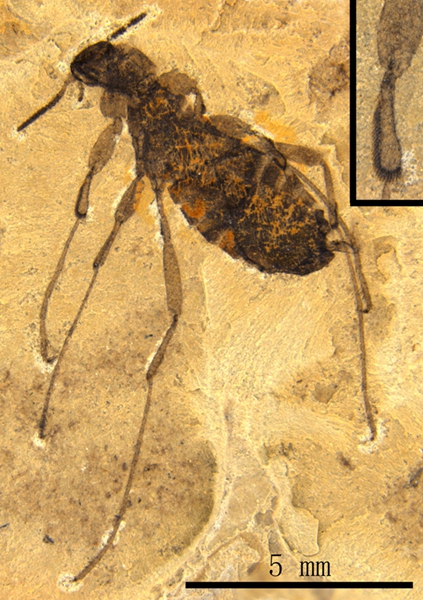The Australian Lower Cretaceous Koonwarra fossil bed (ca. 118 Ma) has yielded abundant plants, vertebrates and invertebrate fossils, including insects, spiders and branchiopods. The flea, Tarwinia, is one of the most arresting fossils among them.
In 1970, two different fleas, Tarwinia (about 7 mm long) and Niwratia, were reported by an Australian paleontologist Riek in Nature. Niwratia is small, and it was thought to be closely related to modern fleas; whereas the holotype of Tarwinia preserved sufficient morphological details and probably some ancestral features, making it a hotspot for scientists’ attention. Tarwinia has been well known for the sole definitive Mesozoic flea fossil before diverse transitional fleas reported in Nature from the Middle Jurassic Daohugou biota (ca. 165 Ma) and the Early Cretaceous Jehol biota (ca. 125 Ma) of northeastern China by Prof. HUANG Diying from Nanjing Institute of Geology and Palaeontology, Chinese Academy of Science in 2012. However, the systematic position of Tarwinia is controversial: paleontologists generally agree that Tarwinia presents a member of Siphonaptera, while neontologists do not agree. The reason accounting for this situation is probably the inaccurate description of Tarwinia. For instance, siphonate mouthparts are well developed in extant fleas, while the structure is not found in Tarwinia. In Evolution of Insect by Grimaldi and Engel (2005), it was pointed out that Tarwinia does not possess siphonate mouthparts. In 2012, Huang et al. indicated that as seen from the figures in that book the piercing and sucking mouthparts are probably present in Tarwinia. The discovery of the diverse giant fleas from the Mesozoic of China also support that Tarwinia belongs to Siphonaptera. In 2013, Tarwinia was elevated to a new family status by Huang and his colleagues.
In November of 2013, HUANG Diying visited the Victoria Museum in Melbourne, Australia and restudied the holotype of Tarwinia. He confirmed for the first time that the other flea genus Niwratia is in fact a libellulid larva of Odonata and has no affinity with fleas. The description of Tarwinia is inaccurate, so Tarwinia was restudied by Huang and the result was recently published online in Cretaceous Research.
New examinations confirm that Tarwinia has siphonate mouthparts, and special sensilla-bearing pygidium is present near the apex of its abdomen. Some authors thought that Tarwinia is a relatively derived Mesozoic flea as supported by its laterally compressed body, while it is due to the misunderstanding of the preservation. Huang argues that Tarwinia has affinity with the giant fleas from the Middle Jurassic and Early Cretaceous of China, and they differ in the morphology of the ctenidia on tibiae. Like other Mesozoic fleas, Tarwinia only has ctenidia on tibiae, but ctenidia are very long and comb-like, and located at the apical and outer edges. In the head, thorax, or abdomen of extant fleas, different ctenidia are developed, making the fleas from being removed from their hosts. The ctenidia are only present on tibiae, and their different morphology likely suggests different adaption to hosts. It is possible that Tarwinia and other Mesozoic fleas were derived from the same ancestor. Before the Middle Jurassic, a time when Pangaea was not completely broken up, the flea ancestor has had likely immigrated to every continent with their hosts. With the break up of Pangaea and the Early Cretaceous Australia was distinctly separated from other continents, the ecological isolation made early vertebrates evolve separated, making their parasites have the morphological adaption accordingly and evolve to specialized species. The possibility that the comb-like ctenidia was associated with feathers cannot be ruled out, as a number of diverse early birds or feathered dinosaurs have been discovered, and bird feathers were also found in Tarwinia-bearing strata.
This research was supported by the National Basic Research Program of China, Outstanding Youth Foundation of Jiangsu Province, and the National Natural Science Foundation of China.
Related information of the paper: Huang, Diying (2014): Tarwinia australis (Siphonaptera: Tarwiniidae) from the Lower Cretaceous Koonwarra fossil bed: Morphological revision and analysis of its evolutionary relationship. Cretaceous Research, http://dx.doi.org/10.1016/j.cretres.2014.03.018

Tarwinia australis from Lower Cretaceous Koonwarra fossil bed of Australia, the enlarged pictures indicate the ctenidia on fore tibia.
Download:
